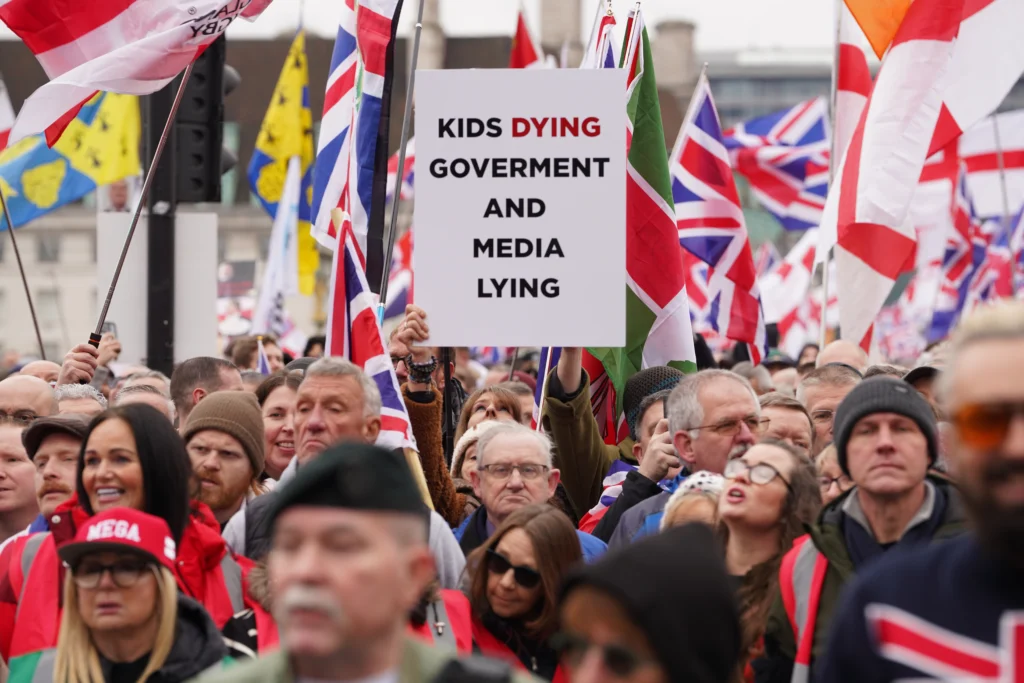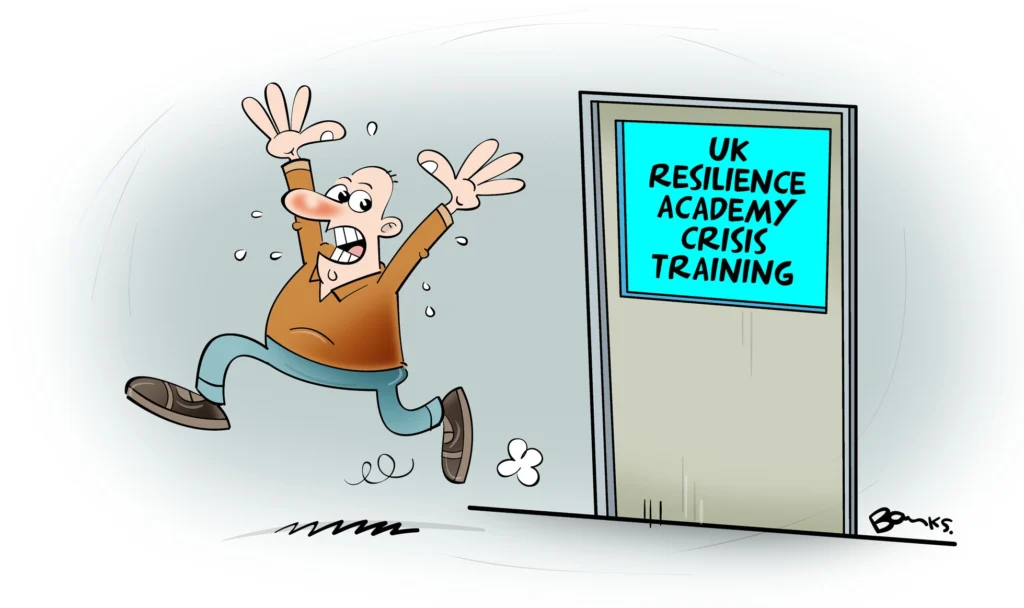Article
Eyewitness: contentious rival protests well policed

Chris Hobbs attends two protests with the potential for trouble with a policing plan in place to keep the two groups apart.
Tourists and visitors in the vicinity of Eros in Piccadilly, who could be seen chatting to and posing with smiling Met officers for ‘selfies,’ would assume that there was nothing untoward occurring in central London. However, those familiar with policing would be quick to observe that the officers were wearing flameproof ‘coveralls,’ baseball caps and, most tellingly of all, had ‘riot’ helmets clipped to their belts.
Enquiries would have revealed that there were two potentially contentious events in central London involving, on one side the supporters of Tommy Robinson whilst on the other anti-racists from a plethora of leftist organisations. The job of the Met commanders was to ensure that both sides could have their say while ensuring a peaceful afternoon; this would only be achieved by keeping both sides apart.
The anti-racists met in St. James Street close to Green Park, where there was a carnival atmosphere together with a good choice of music from powerful speakers. It was, however, noticeable that officers had singled out and were talking to, a masked male in a green hoody. He was to have a further encounter with police later in the afternoon.
Who let the dogs out?
I retraced my steps back to Piccadilly and found a group with banners approaching from the other direction. Initially I thought they were heading for the anti-racist protest, but their placards were referring to hunting dogs in Spain and unusually a number of participants were accompanied by dog; each looked like a cross between a greyhound and a whippet. Most of the dogs wore jackets to protect them from the cold.
Both participants and the dogs were extremely well behaved, kept to the footways and did not require any form of police supervision. Later I discovered that the dogs and hundreds like them were used every year during the Spanish hunting season. The protest was due to the fact that at the end of each and every hunting season the dogs were destroyed and new animals acquired just before the start of the next hunting season the following year.
Rendezvous at Waterloo

Just outside Waterloo station, crowds gathered for what was in essence a ‘support Tommy Robinson’ march and rally, which was billed under the heading of ‘stop the isolation,’ presumably a reference to his being placed in ‘solitary’ due to fears for his safety. Needless to say, there was an abundance of Union and St. George flags together with placards demanding his release. There was also a very visible security personnel presence and a large number of stewards. Effective stewarding seems to have been a hallmark of most large public order events over the past 14 months; issues seem more prevalent at the smaller protests.
There was, apparently, an arrest at Waterloo for spitting at a police officer but all seemed in order as the march set off at the agreed start time of 1pm. Formidable looking security personnel were at the head of the march and controlled its progress. Just before the right turn onto Westminster Bridge, participants would have seen a formidable presence of TSG carriers and officers.
There were few barriers, police cordons and bewildering detours on this occasion as opposed to the last protest and counter-protest, but the positioning of carriers and units meant that any attempt by sizeable groups to outflank police and confront their rivals would be doomed to failure.
The ‘Stop the Isolation,’/’Unite the Kingdom’ rally
As the crowds passed Westminster Station and turned left into Parliament Street, which is an extension of Whitehall, they would have seen the first of two giant screens that relayed events from a stage situated close to the Cenotaph. Whilst both rival groups were located in Whitehall, neither had sight of the other, which considerably reduced tensions.
Those attending the rally and curious tourists were greeted by ‘Rule Brittania’ as they progressed towards the stage while large but patient queues built up outside the block of ‘portaloos. ‘
As I was leaving to observe the anti-racist rally located at the far end of Whitehall, on one side of Parliament Street I noticed a distressed black lady. She approached a serial of officers who were making their way towards Downing Street from Parliament Square. They all stopped and clearly concerned, clustered round.
Whatever the issue was, I don’t think it was connected to the rally, but after a short while a male and female officer detached themselves from their colleagues and made their way back, with the female, towards Parliament Square doubtless to deal with whatever the issue was.
Anti-racists rally

The detour to the anti-racist rally took me along the Embankment and then up Northumberland Avenue to Trafalgar Square which enabled me to join the anti-racist gathering from the rear. As I entered Whitehall, my eardrums were assaulted by what could only be described as some sort of harsh techno music. It was coming from a group of about 40 individuals dressed in black, masked and mainly hooded. They were prancing around to the ‘techno’ which drowned out the speeches from the stage.
These were, I was told, anarchists, who did not ‘get on’ with the other clearly visible leftist groups present complete with stalls. In order to hear the speeches, I had to move closer to the stage. Although there was an appreciative audience, the numbers were not as great as had been anticipated.
There was a brief disturbance on the footway and it soon became clear that it involved the previously mentioned masked male in the green hoody who had been identified by those in the audience as an interloping ‘fascist.’ He was surrounded by officers and escorted out of Whitehall followed by a baying crowd.
I later discovered that whilst viewing the rally at the ‘Parliament Square’ end, I had missed arguably the most serious but predictable incident of the day.
‘Inserts’ attempt to disrupt the rally

During the past twelve months, the Palestine protests have inevitably seen incidents involving a small group of pro-Israeli activists who have sought to provoke a reaction from their rivals by either inserting themselves amongst pro-Palestinians during their rallies or by obstructing their marches. They wave banners and complain bitterly when police intervene stating that their rights of freedom of expression and freedom of movement are being abused.
An intervention was expected as ‘inserts’ had materialised at the last anti-racist protest in Whitehall.
I’m told by photo-journalists who were present, that this group worked their way to the front of the crowd before unfurling a banner. They were quicky surrounded by stewards and the situation appeared resolved. However, this group then appeared to attempt to climb on to the stage which resulted in scuffles with stewards. Police intervened and three of the ‘Inserts’ were arrested before order was restored.
Equally predictable was the reaction of those ‘Inserts’ on social media claiming that their rights were being abused and that police brutality was practised by Met officers dealing with them. This claim was reinforced by a cartoon.
It is of course an acceptable police tactic in the UK and indeed across the civilised world, to keep rival groups apart whether at politically driven protests and rallies or at football matches. If leftist groups had attempted to ‘insert’ themselves at the ongoing Tommy Robinson rally just down the road with placards stating ‘Nazi scum off our streets,’ or ‘all migrants welcome here,’ there would almost certainly be a robust reaction from those attending.
At a pro-Tommy Robinson rally in June, a youth displaying a Palestinian flag ran along the edge of Trafalgar Square. He was pursued by some of the crowd that had seen him and only swift intervention by stewards and police prevented a potentially unpleasant incident. It’s hard not to associate the attitude of the ‘inserts’ with the term hypocrisy and their actions provide the Met with unnecessary challenges both during the incident and subsequently, in relation to legal proceedings.
An early finish
The anti-racist rally ended surprisingly early at just after 3pm; the conditions imposed/agreed stated that the rally had to conclude by 5.30pm. Interestingly a number of the departing protesters could be seen conversing with police and apparently thanking them.
It was however still a long detour back to the other end of Whitehall where the ‘stop the isolation’ rally was continuing. I had already been informed that the crowd had thinned appreciably but there was still considerable enthusiasm amongst those clustered in the vicinity of the stage.
A point of interest
Whilst not paying too much attention to the speakers, I did hear one comment that in the USA, the Trump administration would be, in effect, going after those who had been responsible for prosecuting individuals involved in the January the 6th riot. That speaker went on to suggest that the same path would be followed here; presumably a reference to the UK’s summer riots and the incarceration of Tommy Robinson.
It was therefore interesting to hear over the weekend, numerous reports that the US Department of Justice was removing January the 6th prosecutors from office and that FBI agents involved in those prosecutions, could also lose their jobs.

As this rally came to a peaceful close, those assembled received a blessing from a clergyman and the final act of the organisers was to play Neil Diamond’s feel good ‘Sweet Caroline,’ which, as I and one or two police officers found out, is almost impossible NOT to singalong to.
The relatively few police officers left in the vicinity as the crowd dispersed, as with the other rally, found themselves being thanked by a number of those departing.
In all there were just six arrests, including the three above mentioned ‘inserts’ which, considering the tensions currently existing, was a testimony to the successful, balanced, policing operation which will doubtless receive credit from nobody.
As has become usual with these protests, be they emanating from the right or the left, there were wild claims as to the numbers attending. The reality was that, as confirmed by both officers and impartial journalists and observers who attend these events on a regular basis, between five and seven thousand individuals attended the ‘stop the Isolation’ rally and between two and three thousand, the anti-racist counter protest.
The one factor they both had in common, and which, as previously alluded to, seems a feature of most major protests which have occurred over the past 15 months, is the effective stewarding as well as the effective policing. However, galvanised by the actions and proposals of Donald Trump, the next major pro-Palestine protest on the 15th of February will conclude with a rally adjacent to the US Embassy at Nine Elms. Let us hope that the above ‘effective’ comments don’t temp fate.
Category: OpsPublic Order
Advertisement
Job of the week
Commissioner of Police

- Royal Virgin Islands Police Force
- British Virgin Islands
- $104,727.00 - $178,035.00 per annum
The Royal Virgin Islands Police Force (RVIPF) seeks an exceptional leader for the role of Commissioner of Police on a three-year renewable contract. This critical position demands a highly strategic and experienced police leader who will provide executive leadership in policing operations, administration, and strategic direction for the Force. Reporting directly to the Governor of the Virgin Islands, the Commissioner will work in close collaboration with other key stakeholders to ensure the highest standards of policing excellence and public safety across the Territory.
Read more

